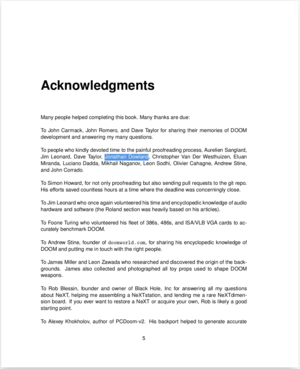jmtd → log → Game Engine Black Book: DOOM
Today is Doom's' 25th anniversary. To mark the occasion, Fabien Sanglard has written and released a book, Game Engine Black Book: DOOM.
It's a sequel of-sorts to "Game Engine Black Book: Wolfenstein 3D", which was originally published in August 2017 and has now been fully revised for a second edition.
I had the pleasure of proof-reading an earlier version of the Doom book and it's a real treasure. It goes into great depth as to the designs, features and limitations of PC hardware of the era, from the 386 that Wolfenstein 3D targetted to the 486 for Doom, as well as the peripherals available such as sound cards. It covers NeXT computers in similar depth. These were very important because Id Software made the decision to move all their development onto NeXT machines instead of developing directly on PC. This decision had some profound implications on the design of Doom as well as the speed at which they were able to produce it. I knew very little about the NeXTs and I really enjoyed the story of their development.
Detailed descriptions of those two types of personal computer set the scene at the start of the book, before Doom itself is described. The point of this book is to focus on the engine and it is explored sub-system by sub-system. It's fair to say that this is the most detailed description of Doom's engine that exists anywhere outside of its own source code. Despite being very familiar with Doom's engine, having worked on quite a few bits of it, I still learned plenty of new things. Fabien made special modifications to a private copy of Chocolate Doom in order to expose how various phases of the renderer worked. The whole book is full of full colour screenshots and illustrations.
The main section of the book closes with some detailed descriptions of the architectures of various home games console systems of the time to which Doom was ported, as well as describing the fate of that particular version of Doom: some were impressive technical achievements, some were car-crashes.
I'm really looking forward to buying a hard copy of the final book. I would recommend this to anyone has fond memories of that era, or is interested to know more about the low level voodoo that was required to squeeze every ounce of performance possible out of the machines from the time.
Edit: Fabien has now added a "pay what you want" option for the ebook. If the existing retailer prices were putting you off, now you can pay him for his effort at a level you feel is reasonable. The PDF is also guaranteed not to be mangled by Google Books or anyone else.

